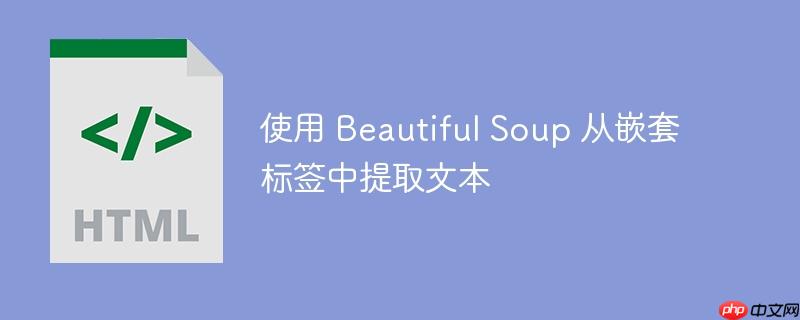
本文档旨在解决在使用 Beautiful Soup 解析 HTML 时,如何从嵌套标签中准确提取文本的问题。我们将通过实例演示如何使用 find_next(text=True) 方法以及 .get_text(strip=True) 方法来获取所需数据,并提供完整的代码示例和注意事项,帮助开发者更好地理解和应用 Beautiful Soup。
在使用 Beautiful Soup 解析 HTML 时,经常会遇到需要从嵌套标签中提取文本的情况。直接使用 .text 属性可能会遇到 AttributeError: ‘NoneType’ object has no attribute ‘text’ 错误,这通常是因为 Beautiful Soup 无法直接找到包含文本的标签。本文将介绍如何正确地从嵌套标签中提取文本,并提供示例代码。
使用 find_next(text=True) 方法
当目标文本位于一个标签内部的文本节点时,可以使用 find_next(text=True) 方法来定位到该文本节点,然后提取文本。
以下是一个示例 HTML 结构:
<div class="preview-content"> <a class="preview__link" href="/properties/1042-us-highway-1-hancock-me-04634/1330428"> <span class="preview__price"> $89,900 </span> <span class="preview__size"> 1 ac </span> <div class="preview__subtitle"> <h2 class="-g-truncated preview__subterritory"> Hancock County </h2> <span class="preview__extended"> -- sq ft </span> </div> </a> </div>
以下是使用 find_next(text=True) 方法提取价格、大小和县域的代码示例:
from bs4 import BeautifulSoup html = ''' <div class="preview-content"> <a class="preview__link" href="/properties/1042-us-highway-1-hancock-me-04634/1330428"> <span class="preview__price"> $89,900 </span> <span class="preview__size"> 1 ac </span> <div class="preview__subtitle"> <h2 class="-g-truncated preview__subterritory"> Hancock County </h2> <span class="preview__extended"> -- sq ft </span> </div> </a> </div> ''' soup = BeautifulSoup(html, 'html.parser') preview_content = soup.find('div', class_='preview-content') if preview_content: plot_price = preview_content.find('span', {"class": 'preview__price'}).find_next(text=True).strip() plot_size = preview_content.find('span', {"class": 'preview__size'}).find_next(text=True).strip() plot_county = preview_content.find('h2', class_='-g-truncated preview__subterritory').find_next(text=True).strip() print(plot_price) print(plot_size) print(plot_county) else: print("未找到 'preview-content' 类别的 div 元素")
代码解释:
- 首先,使用 BeautifulSoup 解析 HTML 字符串。
- 然后,使用 find() 方法找到 class 为 preview-content 的 div 元素。
- 对于每个需要提取的文本,先找到包含该文本的标签(例如,span 或 h2)。
- 使用 find_next(text=True) 方法找到标签内的文本节点。
- 使用 .strip() 方法去除文本节点前后的空格。
使用 .get_text(strip=True) 方法
.get_text(strip=True) 方法可以提取标签内的所有文本内容,并去除首尾空格。这个方法在处理包含多个子标签的复杂结构时非常有用。
以下是使用 .get_text(strip=True) 方法的示例:
from bs4 import BeautifulSoup html = ''' <div class="preview-content"> <a class="preview__link" href="/properties/1042-us-highway-1-hancock-me-04634/1330428"> <span class="preview__price"> $89,900 </span> <span class="preview__size"> 1 ac </span> <div class="preview__subtitle"> <h2 class="-g-truncated preview__subterritory"> Hancock County </h2> <span class="preview__extended"> -- sq ft </span> </div> </a> </div> ''' soup = BeautifulSoup(html, 'html.parser') preview_content = soup.find('div', class_='preview-content') if preview_content: plot_price = preview_content.find('span', {"class": 'preview__price'}).get_text(strip=True) plot_size = preview_content.find('span', {"class": 'preview__size'}).get_text(strip=True) plot_county = preview_content.find('h2', class_='-g-truncated preview__subterritory').get_text(strip=True) print(plot_price) print(plot_size) print(plot_county) else: print("未找到 'preview-content' 类别的 div 元素")
代码解释:
此示例与前一个示例类似,但使用 .get_text(strip=True) 方法代替了 find_next(text=True) 方法。.get_text(strip=True) 方法直接提取标签内的文本内容,并去除首尾空格。
完整示例:从网页抓取数据
以下是一个从实际网页抓取数据的完整示例:
import requests from bs4 import BeautifulSoup url = 'https://www.landsearch.com/industrial/united-states/p1' res = requests.get(url) soup = BeautifulSoup(res.content, 'lxml') landplots = soup.find_all('div', class_='preview-content') for l in landplots: try: plot_price = l.find('span', {"class": 'preview__price'}).get_text(strip=True) plot_size = l.find('span', {"class": 'preview__size'}).get_text(strip=True) plot_county = l.find('h2', class_='-g-truncated preview__subterritory').get_text(strip=True) print(plot_price) print(plot_size) print(plot_county) except AttributeError: print("部分信息缺失")
代码解释:
- 首先,使用 requests 库获取网页内容。
- 然后,使用 BeautifulSoup 解析 HTML 内容。
- 使用 find_all() 方法找到所有 class 为 preview-content 的 div 元素。
- 对于每个 div 元素,提取价格、大小和县域信息。
- 使用 try…except 块处理可能出现的 AttributeError 异常,例如当某个地块缺少某些信息时。
注意事项
- 处理 NoneType 错误: 在提取文本之前,务必检查找到的标签是否为 None。如果标签不存在,尝试提取其文本属性会导致 AttributeError: ‘NoneType’ object has no attribute ‘text’ 错误。可以使用条件语句来避免此错误。
- 网页结构变化: 网页结构可能会发生变化,因此需要定期检查代码是否仍然有效。如果网页结构发生变化,可能需要修改代码以适应新的结构。
- 使用 strip() 方法: 提取文本后,建议使用 strip() 方法去除文本前后的空格,以确保数据的准确性。
- 异常处理: 在实际应用中,建议使用 try…except 块来处理可能出现的异常,例如 AttributeError 和 TypeError。
总结
本文介绍了如何使用 Beautiful Soup 从嵌套标签中提取文本。通过使用 find_next(text=True) 方法和 .get_text(strip=True) 方法,可以准确地提取所需数据。同时,提供了完整的代码示例和注意事项,帮助开发者更好地理解和应用 Beautiful Soup。希望本文能够帮助读者解决在实际开发中遇到的问题。


